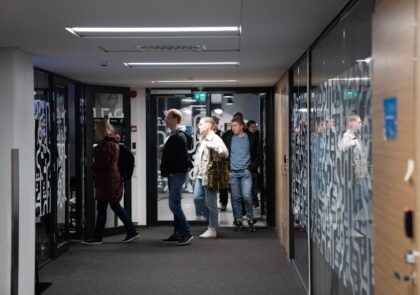
This article explores the prerequisites and challenges of a successful citizen dialogue, which is needed to solve societal and environmental issues inclusivily. The article is referring to the Interreg Europe funded CECI – Citizen involvement in circular economy implementation project and the CECI Thematic Study survey, that was carried out in April 2020.
Authors: Lauren Miller, Antoine Delaunay-Belleville, Marjut Villanen & Katerina Medkova

Image 1. CECI – Circular economy blooms through citizens involvement. (Rouhiainen 2020)
How to build up collaboration and engagement
Enabling citizens to collaborate in the field of public actions, is today a major challenge to solve social and environmental issues. According to the Rio Declaration, public policies on the environment can only be relevant and functional if they involve the participation of all the citizens concerned (United Nations 1992).
Although citizen involvement is needed, the opportunities for real and concrete citizen participation are often rare and shallow. While developing and increasing citizen involvement, several important issues, that need to be considered, can be identified:
- Transparency: Making clear outlines before, during and after the process – on the contribution, the decision-making power, the timeframes, methodology and tools used.
- Shared expertise: Considering, that each person is endowed with individual expertise, that deserve to be shared, and that everyone is capable and worthy of making informed decisions for the common good if given the time to learn.
- Experimentation: Sharing points of view, asking questions, listening, experimenting, changing plans and scales, recognizing power relations and above all, moving away from the bureaucracy.
- Benevolence: Collaboration cannot be decreed, but it is based on the free will of people who want to work together despite their differences.
- Accessibility: Making places, times, and vocabulary of decision-making accessible to all equally.
There are several guidelines and tips to help organizers and organizations to reach out to citizens and to settle a convenient atmosphere to raise and discuss various issues (Miller et al. 2020a). Among the key points to be considered when reaching diverse citizens are:
- Mapping citizens for better representativity: Rely on local actors that already have the trust of people. Ask community centres for recommendations and be sure to include the people affected by the decisions. (Ericson 2016.)
- Make your intention and message clear: Apply transparency and clarity of potential outcomes and remember the Aarhus Convention principles (European Commission 2020a, UNECE 1998).
- Create a welcoming atmosphere for all: Offering refreshments and icebreaker help participants to relax. Consider accessibility for all.
What should be considered when triggering a successful dialogue with people? Talking, listening, asking questions, and dedicating time to participants are vital activities. Careful selection of language use, avoiding professional jargon, contributes to a better understanding of the message.
Involvement requires networking and organizational approach
Some initiatives have noticed that many citizens draw away after a few years because of administrative problems, lack of funding, support, or expertise. These drawbacks can be countered with appropriate questions, training, and processes.

Image 2. Successful community network take advantage of various citizens expertise. (Pexels 2016)
- Rely on networks: Creating a local solidarity network where citizen initiatives can work along with civil servants to acquire skills, resources and expertise (Holmén 2002).
- Value citizen expertise and success: One of the basics of community organizing, is to focus on existing leaders, initiatives and quick wins to motivate people. This allows people to gain confidence in their power, to become eager to bond together, to get further involved long term and to feel comfortable in public discussions. (Fischer 2000.)
- Regional, national, and international networks: Help international movements settle on your territories and bring tools, legitimacy, expertise, events, and enthusiasm to your territories. When ushered in broader networks, citizens may be able to get training, supports, and a possibility to participate in momentums. A community may also feel more legitimate to give their opinion. Helping similar regional structures to work together in syndicates and unions help them better express their common requests and suggestions. Their collaboration may foster mutual resources and skills and enable higher visibility through collective actions. (Holmén 2002.)
- Resilient organizations: Use appropriate structures and facilitation methodologies to make sure you have defined and made accessible the vision, mission, and values of the project. Worth to mention are methodologies, such as Inclusion, User journey and exclusion of members, Use of the communication channel, Decision process and roles attribution, and Content and data management (Community Canvas 2020).
Constructive conflicts
Conflicts arise from a change that is perceived by local actors as opposed to their interest. As conflicts can slow down the general agenda, sometimes they are avoided by ignoring or silencing opponents that lead to a loss of the decision legitimacy. (Fowler et al. 2016. )
Well managed concertation allows going beyond oppositions to reach a common goal. The decision is legitimate when it results from a process, in which the public and other stakeholders have participated in the process. The legitimacy of the decision is based on transparency, rigour, impartiality, and fair procedure and debate. However, for citizens to regain confidence, the debate must take place early enough, before decisions are taken, when essential choices are not decided, and other options are still possible. (Ministère de la Transition écologique et solidaire 2015.)
To conclude, involving citizens is crucial for circular economy implementation as they are the consumers and users influencing future development and the transition of the consumer market. Moreover, all the stakeholders shall have their say in the process as called the ‘right of initiative’ proposed by the EU law (European Commission 2020b).
Citizens play an important role also in proposing and testing new ideas and innovations. The public sector needs to act in such a way that supports citizen involvement. However engaging citizens is challenging. This is a competence that needs to be taught and continuously developed. The Interreg Europe funded project CECI – Citizen involvement in circular economy implementation, provides measures for a better collaboration between municipalities, businesses and citizens to achieve a favourable environment that encourages sustainable circular practices, business and economic growth (Interreg Europe 2020).
This article is referring to the Interreg Europe funded CECI – Citizen involvement in circular economy implementation project and the CECI Thematic Study survey, that was carried out in April 2020. (CECI 2020). Based on the survey a series of three articles have been written. The first article summarizes the policy situation and collaboration between authorities and citizens (Virtanen et al. 2020). The second one sums up real-life examples of citizen participation in circular economy and identifies the four pillars of attractive citizen communities (Miller et al. 2020a) and the third explores the prerequisites and challenges of a successful citizen dialogue (Miller et al. 2020b)
This article reflects the authors’ views; the Interreg Europe programme authorities are not liable for any use that may be made of the information contained therein.
References
CECI. 2020. CECI Thematic study survey. Unpublished.
Community Canvas. 2020. A framework to help you build meaningful communities. [Cited 6 Oct 2020]. Available at: https://community-canvas.org/
Erickson, J. 2016. Targeting minority, low-income neighborhoods for hazardous waste sites. Michigan news. [Cited 6 Oct 2020]. Available at: https://news.umich.edu/targeting-minority-low-income-neighborhoods-for-hazardous-waste-sites/
European Commission. 2020a. The Aarhus Convention. [Cited 6 Oct 2020]. Available at: https://ec.europa.eu/environment/aarhus/index.htm
European Commission. 2020b. Planning and proposing law. [Cited 6 Oct 2020]. Available at: https://ec.europa.eu/info/law/law-making-process/planning-and-proposing-law_en
Fowler, A., McMahon, J. & Field, E. 2016. Conflict Within International Nonprofit Development Organisations: Expressions, Origins, Capabilities and Remedies. Conference paper. [Cited 8 Oct 2020]. Available at : https://www.researchgate.net/publication/305719283_Conflict_Within_International_Nonprofit_Development_Organisations_Expressions_Origins_Capabilities_and_Remedies
Fischer, F. 2000. Citizens, Experts, and the Environment. Duke University Press. [Cited 8 Oct 2020]. Available at : http://socialnaekonomija.si/wp-content/uploads/Citizens__Experts__and_the_Environment__The_Politics_of_Local_Knowledge.pdf
Holmén, H. 2002. NGOs, Networking, and Problems of Representation. ICER Working Papers 33-2002. ICER – International Centre for Economic Research. [Cited 8 Oct 2020]. Available at : https://www.researchgate.net/publication/5106083_NGOs_Networking_and_Problems_of_Representation
Interreg Europe. 2020. Project summary. CECI. [Cited 6 Oct 2020]. Available at: https://www.interregeurope.eu/ceci/
Miller, L., Delaunay-Belleville, A., Villanen, M. & Medkova, K. 2020a. Triggering citizen involvement. LAB Pro. [Cited 20 Oct 2020]. Available at: https://www.labopen.fi/lab-pro/triggering-citizen-involvement/
Miller, L., Delaunay-Belleville, A., Villanen, M. & Medkova, K. 2020b. Reaching for Successful Citizen Dialogue. LAB Pro. [Cited and date of citation]. Available at: https://www.labopen.fi/en/lab-pro/reaching-for-successful-citizen-dialogue/
Ministère de la Transition écologique et solidaire. 2015. La charte de la participation du public. [Cited 8 Oct 2020]. Available at: https://www.ecologie.gouv.fr/charte-participation-du-public
UNECE. 1998. Convention on Access to Information, Public Participation in Decision-Making and Access to Justice in Environmental Matters. Sustainable Development Goals. [Cited 6 Oct 2020]. Available at: https://www.unece.org/fileadmin/DAM/env/pp/documents/cep43e.pdf
United Nations. 1992. Report of the United Nations conference on environment and development. [Cited 6 Oct 2020]. Available at: https://www.un.org/en/development/desa/population/migration/generalassembly/docs/globalcompact/A_CONF.151_26_Vol.I_Declaration.pdf
Virtanen, M., Snell, J., Villanen,M. & Medkova, K. 2020. From strategies to grassroot actions in circular economy. LAB Pro. [Cited 20 Oct 2020]. Available at: https://www.labopen.fi/lab-pro/from-strategies-to-grassroot-actions-in-circular-economy/
Images
Image 1. Rouhiainen, O. 2020. Circular economy blooms through citizens involvement. CECI.
Image 2. Pixabay. 2016. Person Gather Hand and Foot in Center. Pexels. [Cited 6 Oct 2020]. Available at: https://www.pexels.com/photo/person-gather-hand-and-foot-in-center-53958/
Authors
Lauren Miller works as a community building expert at makesenses and a CECI advising partner
Antoine Delaunay-Belleville works as circular economy specialist at makesense and a CECI advising partner
Marjut Villanen works as an RDI specialist at LAB University of Applied Sciences and is the CECI Project Manager
Katerina Medkova works as an RDI specialist at LAB University of Applied Sciences and is the CECI Communication Manager.
Illustration: https://pxhere.com/fi/photo/602101 (CC0)
Published 21.10.2020
Reference to this article
Miller, L., Delaunay-Belleville, A., Villanen, M. & Medkova, K. 2020. Reaching for Successful Citizen Dialogue. LAB Pro. [Cited and date of citation]. Available at: https://www.labopen.fi/en/lab-pro/reaching-for-successful-citizen-dialogue/






